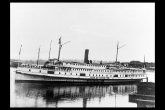Shipwreck S/S KINGSTON
The Kingston was built in Sunderland by the Oswald Shipbuilding Company, and launched on 16th February 1871. She was technically described as an “Iron, Screw, Brigantine” and was one of a relatively new breed of ship which had a funnel as well as two masts.
Powered by a single, 2 cylinder compound steam-engine, the Kingston was capable of a top speed of 11 knots. She was a general cargo vessel and measured 78m long, 10m wide and had draught of 6m. She displaced 1,449 gross registered tons.
The Loss of the Kingston
On the morning of 20th January 1881, Captain Cousins sailed from London in charge of the Kingston – the destination was Aden.
Sailing via the Mediterranean and the Suez Canal, the Kingston finally cleared Suez on 20th February 1881. Cousins decided to remain in charge of the ship for the entire length of the Straits of Suez himself. He took no rest as he continued to double check every single detail of navigating the Kingston safely through some very treacherous waters. Then at long last, the Kingston was nearing the open Red Sea and, even though it was now dark, Cousins felt that the immediate dangers were now over and that he could relax. He duly gave some short and sharp instructions to the First Mate and retired to his cabin. He had been awake for almost 2 days…
In the early hours of February 22nd the Kingston struck Shag Rock. Within moments, the Captain was back on the bridge and taking charge of the situation.For two days the crew fought to keep the Kingston afloat but it was a lost cause. Knowing that help would not be long in arriving, Cousins remained on the Kingston until the last possible moment when the Kingston suddenly settled by the stern. The Kingston then slipped gracefully backwards from the Reef. Soon, only the Masts were visible and it was right next to these Captain and Crew were found – less than two hours later. No injuries or loss of life was sustained.
Sources:Internet







